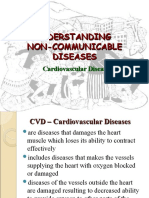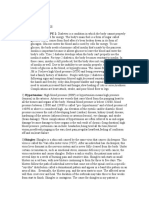Lesson 2
Lesson 2
Uploaded by
Gwyneth Hezekiah PradoCopyright:
Available Formats
Lesson 2
Lesson 2
Uploaded by
Gwyneth Hezekiah PradoOriginal Title
Copyright
Available Formats
Share this document
Did you find this document useful?
Is this content inappropriate?
Copyright:
Available Formats
Lesson 2
Lesson 2
Uploaded by
Gwyneth Hezekiah PradoCopyright:
Available Formats
NON-COMMUNICABLE DISEASES AND
PHYSICAL ACTIVITY
LESSON 2
Heart Attack Warning Signs
a non-communicable disease (NCD) is a
medical condition or disease that is non- chest discomfort that can feel like
infechous and non-transmissible. uncomfortable pressure, squeezing or
pain that lasts for more than a few
Estimated that 6-10 deaths in the world are minutes, or that goes away and returns
attmbuted to NCDs cardiovascular disease, later;
diabetes, cancer, and risk factors, which Pain or discomfort in the shoulders,
include elevated blood sugar and neck, jaw, between the shoulder
overweight. blades, in one or both arms;
Shortness of breath that accompanies
2010 WHO reported that main causes of NCDs the chest discomfort;
are known: and Light-headedness, cold sweats,
nausea, and/or vomiting,
UN HEALTHY DIET
PHYSICAL INACTIVIT High Blood Pressure or Hypertension
TOBACCO USE
Hypertension
CARDIOVASCULAR DISEASE (CVD) refers to a chronic, persistent elevation
of blood pressure. Pressure is created
A group of degenerative condition that when the heart contracts, pump blood
afflicts the heart and the vessel. Includes into the arteries, and blood is forced
coronary heart, strokes, hypertension or against the walls of the arteries as it
high blood pressure and heart failure. circulates throughout the body.
CORONARY HEART DISEASE Stroke
Coronary heart diseases (CHDs) are It is a damage to part of the brain that is caused
caused by a lack of blood supply to the by an interruption of blood supply to the brain
heart muscle resulting from a due to either rupture and leakage (hemorrhage)
progressive, degenerative disorder or blockage (ischemic) of blood vessels. The
known atherosclerosis. Atherosclerosis term stroke indicates the sudden onset.
involves a build-up and deposition of fat
and fibrous plaques in the inner lining of Stroke Warning Signs
arterial wall thereby narrowing it.
Sudden weakness or numbness of the
Atherosclerosis Plaque can face, arm, or leg particularly on one
accumulate in an artery which can side of the body.
eventually block the blood flow. This Sudden confusion, dizziness, difficulty
can cause stroke, heart attack, and with speech and understanding.
even death. Sudden visual difficulty in one or both
eyes.
sudden trouble walking, loss of
balance, or coordination.
Sudden severe headache
Heart Failure
A life-threatening condition were sufficient blood
flow to the body because of the heart's weak
pumping action. Also called 'congestive heart
failure. It can be caused by diseases that:
Weaken the heart muscle, Cause stiffening of
the heart muscles, or Increase oxygen demand
by the body tissue beyond the capability of the
heart to deliver adequate oxygen-rich blood.
NON-COMMUNICABLE DISEASES AND
PHYSICAL ACTIVITY
LESSON 2
Risk Factor Family History
A lifestyle behaverior, an environmental
exposure, or a hereditary characteristic that is
associated with an increase in the occurrence
of a particular disease, injury, or other health
condition.
Modifiable factors
Factors that are within one’s control and can be
changed to prevent disease and/or reduce
deaths
Hypertension
Obesity
Hypercholesterolemia
Diabetes
Physical Inactivity
HYPERTENSION
Hypertension increases the workload of the
heart, resulting in weakening over time.
When this is accompanied by other risk
factors such as obesity, smoking, high
blood cholesterol or diabetes, the risk of
heart attack or stroke increases several
times.
OBESITY
It is a medical condition characterized by
storage of excess bodyfat. A BMI at or
above 85th percentile and lower than the
95th percentile for children of the same age
and sex.
DIABETES
Diabetes mellitus is a group of diseases
characterized by high levels of blood
glucose because the body does not
produce or properly use insulin. Insulin is a
hormone secreted by the pancreas and is
essential for the proper metabolism of
glucose and maintenance of glucose level
in the blood.
PHYSICAL INACTIVITY
is a behavior that can be conceived as a
continuum from minimal to maximal
movements with its corresponding energy
expenditure.
Unmodified Risk factor
that cannot be changed such as:
Age
Sex
You might also like
- Non-Communicable Diseases and Physical InactivityDocument37 pagesNon-Communicable Diseases and Physical InactivityMiles MontinolaNo ratings yet
- Cardiovascular DiseasesDocument6 pagesCardiovascular DiseasesArli MiscalaNo ratings yet
- Cardiovascular Diseases - Group2Document26 pagesCardiovascular Diseases - Group2Ayesha WattooNo ratings yet
- Science Presentation 143 Alabyu MamDocument10 pagesScience Presentation 143 Alabyu Mammkguiao2020No ratings yet
- Pe 1 Lesson 2 Non-Communicable DiseasesDocument79 pagesPe 1 Lesson 2 Non-Communicable Diseasesdario serranoNo ratings yet
- Coronary Artery Disease Seminar 1 Clinical SpecialityDocument20 pagesCoronary Artery Disease Seminar 1 Clinical SpecialityPriyanka PatelNo ratings yet
- Various Types of Disease Part 01Document15 pagesVarious Types of Disease Part 01Sathya NethuNo ratings yet
- Cardiovascullar IllnessesDocument34 pagesCardiovascullar Illnessesdan.ojoy18No ratings yet
- MODULE-3-DISEASES-B(2)Document35 pagesMODULE-3-DISEASES-B(2)itsmeasxbrinNo ratings yet
- Cardiovascular DiseaseDocument11 pagesCardiovascular DiseaseMimi LabindaoNo ratings yet
- The Heart-1Document30 pagesThe Heart-1Ebuka AniNo ratings yet
- Some General First Aid Notes Heart DiseaseDocument12 pagesSome General First Aid Notes Heart DiseaseSavannah Simone PetrachenkoNo ratings yet
- In Partial Fulfillment of The Requirements in Medical Ward RotationDocument5 pagesIn Partial Fulfillment of The Requirements in Medical Ward RotationEiz CabreraNo ratings yet
- Cardiogenic Shock GRP 2Document28 pagesCardiogenic Shock GRP 2LeeyanBhadzzVagayNo ratings yet
- Congestive Heart FailureDocument12 pagesCongestive Heart FailureNader Smadi83% (6)
- Heart Disease & StrokeDocument18 pagesHeart Disease & StrokeSpongeNo ratings yet
- Heart Failure Nursing Care Management - A Study GuideDocument16 pagesHeart Failure Nursing Care Management - A Study GuideJOSHUA DICHOSONo ratings yet
- Word Brochure Template 7 InsideDocument1 pageWord Brochure Template 7 InsideAnonymous ejce48emNo ratings yet
- Subjective Data: Do You Experience Chest Pain?Document9 pagesSubjective Data: Do You Experience Chest Pain?Ellias RoseNo ratings yet
- Adoptante-Myocardial Infarction ReportDocument27 pagesAdoptante-Myocardial Infarction Reportjoyrena ochondraNo ratings yet
- CardioDocument28 pagesCardioJuliana BusuegoNo ratings yet
- Cardio InternetDocument46 pagesCardio InternetnaimNo ratings yet
- CVDsDocument35 pagesCVDsPrakruthi LNo ratings yet
- Heart FailureDocument17 pagesHeart FailureIsna IndahNo ratings yet
- Heart DiseaseDocument26 pagesHeart DiseaseJulia MarieNo ratings yet
- Types of Heart Failure DescriptionDocument28 pagesTypes of Heart Failure DescriptionDivine Grace Arreglo AbingNo ratings yet
- Acute Myocardial InfarctionDocument9 pagesAcute Myocardial InfarctionZachary CohenNo ratings yet
- CHF & Cardiac ArrestDocument12 pagesCHF & Cardiac ArrestRadhika BirlaNo ratings yet
- 39 Medical Surgical Nursing Mnemonics and Tips 1 Nurseslabs PDFDocument80 pages39 Medical Surgical Nursing Mnemonics and Tips 1 Nurseslabs PDFctt1985100% (4)
- 6th Chapter DDDocument225 pages6th Chapter DDRameen RizviNo ratings yet
- Cardiovascular Diseases: Risk FactorsDocument18 pagesCardiovascular Diseases: Risk FactorsShin QuinnNo ratings yet
- Case 27 (LC Fix)Document14 pagesCase 27 (LC Fix)galih suharno0% (1)
- Stroke - MPharm - HHMDocument52 pagesStroke - MPharm - HHMIsrat Jahan Surovy 2225400672No ratings yet
- Coronary Artery DiseaseDocument46 pagesCoronary Artery DiseaseDaniela Rose OrtalNo ratings yet
- Coronary Heart Disease 2Document14 pagesCoronary Heart Disease 2charmi3964No ratings yet
- Pink Illustrative Simple Healthy Habits Infographic PDFDocument1 pagePink Illustrative Simple Healthy Habits Infographic PDFNurhami NabilahNo ratings yet
- Acquired Cardiac DisordersDocument40 pagesAcquired Cardiac DisordersRajaNo ratings yet
- MNT in Cardiovascular DiseaseDocument26 pagesMNT in Cardiovascular DiseaseJosephine A. BertulfoNo ratings yet
- Case Study: Congestive Heart Failure By: Daniel Angelo E. ArangoDocument7 pagesCase Study: Congestive Heart Failure By: Daniel Angelo E. ArangoDaniel Angelo ArangoNo ratings yet
- Myocardial InfarctionDocument10 pagesMyocardial Infarctionswani5312No ratings yet
- Cardiac FunctionCardiacDocument18 pagesCardiac FunctionCardiacMary Jean Hernani100% (1)
- Heart Attack (Myocardial Infection)Document3 pagesHeart Attack (Myocardial Infection)mbok diyirNo ratings yet
- Pathophysiology of CVD InfarctDocument2 pagesPathophysiology of CVD InfarctIris Caberte86% (7)
- World Stroke Day - 26 October 2021Document2 pagesWorld Stroke Day - 26 October 2021Times MediaNo ratings yet
- L-4 Congestive heart failureDocument4 pagesL-4 Congestive heart failureSarvesh GhawateNo ratings yet
- Myocardial Infarction (MI)Document23 pagesMyocardial Infarction (MI)Abedin Mehmedovic88% (60)
- Pathway HypertensionDocument8 pagesPathway HypertensionannisaNo ratings yet
- Heart Diseases - by GaneshDocument15 pagesHeart Diseases - by GaneshM. GokulakannanNo ratings yet
- Cardiovascular DiseasesDocument16 pagesCardiovascular DiseasesScribdTranslationsNo ratings yet
- Acute Coronary, Angina Pectoris and Myocardial InfractionDocument26 pagesAcute Coronary, Angina Pectoris and Myocardial Infractionabeer alzhoorNo ratings yet
- Definition of TermsDocument5 pagesDefinition of TermsJamapele Alby MaNo ratings yet
- What Is Heart FailureDocument2 pagesWhat Is Heart FailureK Praful KumarNo ratings yet
- 1) DIABETES TYPE 2: Diabetes Is A Condition in Which The Body Cannot ProperlyDocument3 pages1) DIABETES TYPE 2: Diabetes Is A Condition in Which The Body Cannot ProperlyMonica SandharNo ratings yet
- Nursing Management of Patient With CCFDocument34 pagesNursing Management of Patient With CCFJayarani Ashok100% (1)
- Cardiovascular DiseaseDocument27 pagesCardiovascular DiseaseKyrajane EsguerraNo ratings yet
- CHFDocument61 pagesCHFAngeline Lareza-Reyna VillasorNo ratings yet
- Cardivascular Deseases and Diabetes MellitusDocument38 pagesCardivascular Deseases and Diabetes MellitusSyafiqah SabriNo ratings yet
- Prevent and Reverse Heart DiseaseDocument95 pagesPrevent and Reverse Heart Diseaseyhanteran100% (6)
- Reverse and Prevent Heart Disease: Natural Ways to Stop and Prevent Heart Disease, Using Plant-Based Oil-Free Diets (Cure Congestive Heart Failure)From EverandReverse and Prevent Heart Disease: Natural Ways to Stop and Prevent Heart Disease, Using Plant-Based Oil-Free Diets (Cure Congestive Heart Failure)No ratings yet
- E60 Datasheet 2021Document2 pagesE60 Datasheet 2021Rafael CostaNo ratings yet
- Power Electronic Lab 11Document2 pagesPower Electronic Lab 11Muhammed Rafay LakhaniNo ratings yet
- PBT1500 Data SheetDocument3 pagesPBT1500 Data Sheetorlando durandNo ratings yet
- Tangra M 560-580 - 72MDHDocument2 pagesTangra M 560-580 - 72MDHjmhombre.mobisolarphNo ratings yet
- Eng Mining July 2012Document68 pagesEng Mining July 2012RogerJorgeNo ratings yet
- Theoretical and Conceptual DUWTRWHDocument6 pagesTheoretical and Conceptual DUWTRWHReynil LabriagaNo ratings yet
- CBSE Class IV SA I Science Answer Key 2015Document2 pagesCBSE Class IV SA I Science Answer Key 2015SuvashreePradhanNo ratings yet
- Study Skills:: A Research Review of The Cognitive Processes, Interventions, and Positive OutcomesDocument8 pagesStudy Skills:: A Research Review of The Cognitive Processes, Interventions, and Positive OutcomesDaniela TunaruNo ratings yet
- TOEIC 870 QuestionsDocument76 pagesTOEIC 870 QuestionsCường VũNo ratings yet
- To My Future SelfDocument2 pagesTo My Future SelfShy PaguiganNo ratings yet
- Atmanirbhar Bharat Abhiyan: (Relief Package by Government of India)Document27 pagesAtmanirbhar Bharat Abhiyan: (Relief Package by Government of India)Ayushi SrivastavaNo ratings yet
- BADAC-Template-Executive-Order - 2Document5 pagesBADAC-Template-Executive-Order - 2palawanNo ratings yet
- Deku's Real QuirkDocument121 pagesDeku's Real QuirkKiko MiloNo ratings yet
- Biomedical Waste ManagementDocument7 pagesBiomedical Waste ManagementDulal Mahato100% (1)
- Social District MapDocument2 pagesSocial District MapWWMTNo ratings yet
- Favofit 25 Recipes Fruit Infused Water - 2020012Document32 pagesFavofit 25 Recipes Fruit Infused Water - 2020012aenul solikhahNo ratings yet
- 4 Fourth BDS Exam Form - GDCH - JamnagarDocument3 pages4 Fourth BDS Exam Form - GDCH - Jamnagaryuvrajsinh jadejaNo ratings yet
- Validation ReqsDocument11 pagesValidation ReqsBabbooNo ratings yet
- Technical Information Liquiline CM442R/CM444R/ CM448RDocument56 pagesTechnical Information Liquiline CM442R/CM444R/ CM448Rkythuat04 nteNo ratings yet
- EU Maximum Levels For Dioxins and PCBs in Feed Additives - Eurofins ScientificDocument2 pagesEU Maximum Levels For Dioxins and PCBs in Feed Additives - Eurofins ScientificQS Yakult mojokertoNo ratings yet
- Truffle GuideDocument17 pagesTruffle GuidekregnlorNo ratings yet
- Solution Manual For Spanish For Medical Personnel Basic Spanish Series 2nd EditionDocument7 pagesSolution Manual For Spanish For Medical Personnel Basic Spanish Series 2nd EditionJean Silva94% (50)
- Procedure of Morphemic Analysis (The Method of Immediate An Ultimate Constituents)Document2 pagesProcedure of Morphemic Analysis (The Method of Immediate An Ultimate Constituents)АнгелинаNo ratings yet
- 66 DuPont MECS Alloy AcidCoolersDocument2 pages66 DuPont MECS Alloy AcidCoolersMohamed Elayachi100% (1)
- Fire Safety Officer ResumeDocument2 pagesFire Safety Officer ResumeJitendra R. MehiyaNo ratings yet
- Bartending NC II CGDocument33 pagesBartending NC II CGmark jason perezNo ratings yet
- Used Cooking Oil Becomes Biofuel: The Demands For New Eco-Friendly Fuels Are Increasing RapidlyDocument2 pagesUsed Cooking Oil Becomes Biofuel: The Demands For New Eco-Friendly Fuels Are Increasing RapidlyLim Chee SiangNo ratings yet
- Peoria County Jail Booking Sheet 6/11/2016Document5 pagesPeoria County Jail Booking Sheet 6/11/2016Journal Star police documentsNo ratings yet
- Family Life CycleDocument57 pagesFamily Life CycleJardee DatsimaNo ratings yet
- Teaching Ability Question With AnswersDocument23 pagesTeaching Ability Question With AnswersGurpreet Kaur75% (4)

























































































